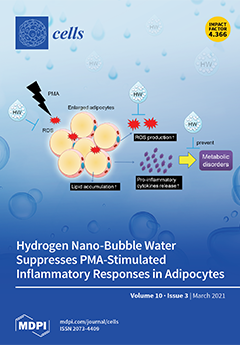Aims: The endocannabinoid system is a complex cell-signaling network through which endogenous cannabinoid ligands regulate cell function by interaction with CB
1 and CB
2 cannabinoid receptors, and with the novel cannabinoid receptor GPR55. CB
1, CB
2, and GPR55 are
[...] Read more.
Aims: The endocannabinoid system is a complex cell-signaling network through which endogenous cannabinoid ligands regulate cell function by interaction with CB
1 and CB
2 cannabinoid receptors, and with the novel cannabinoid receptor GPR55. CB
1, CB
2, and GPR55 are expressed by islet β-cells where they modulate insulin secretion. We have previously shown that administration of the putative CB
2 antagonist/inverse agonist JTE 907 to human islets did not affect the insulinotropic actions of CB
2 agonists and it unexpectedly stimulated insulin secretion on its own. In this study, we evaluated whether the lack of antagonism could be related to the ability of JTE 907 to act as a GPR55 agonist. Materials and Methods: We used islets isolated from human donors and from
Gpr55+/+ and
Gpr55−/− mice and quantified the effects of incubation with 10 μM JTE 907 on dynamic insulin secretion, apoptosis, and β-cell proliferation by radioimmunoassay, luminescence caspase 3/7 activity, and immunofluorescence, respectively. We also measured islet IP
1 and cAMP accumulation using fluorescence assays, and monitored [Ca
2+]
i elevations by Fura-2 single cell microfluorometry. Results: JTE 907 significantly stimulated insulin secretion from islets isolated from human donors and islets from
Gpr55+/+ and
Gpr55−/− mice. These stimulatory effects were accompanied by significant elevations of IP
1 and [Ca
2+]
i, but there were no changes in cAMP generation. JTE 907 also significantly reduced cytokine-induced apoptosis in human and mouse islets and promoted human β-cell proliferation. Conclusion: Our observations show for the first time that JTE 907 acts as a G
q-coupled agonist in islets to stimulate insulin secretion and maintain β-cell mass in a GPR55-independent fashion.
Full article






